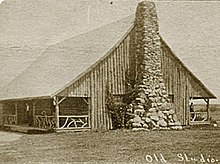
En plein air, or plein-air painting, is the act of painting outdoors.

The Hamptons, part of the East End of Long Island, consist of the towns of Southampton and East Hampton, which together comprise the South Fork of Long Island, in Suffolk County, New York. The Hamptons are a popular seaside resort and one of the historical summer colonies of the northeastern United States.

Southampton is a village in the Town of Southampton in Suffolk County, on the South Fork of Long Island, in New York, United States. The population was 3,109 at the 2010 census.

American Impressionism was a style of painting related to European Impressionism and practiced by American artists in the United States from the mid-nineteenth century through the beginning of the twentieth. The style is characterized by loose brushwork and vivid colors with a wide array of subject matters but focusing on landscapes and upper-class domestic life.

William Merritt Chase was an American painter, known as an exponent of Impressionism and as a teacher. He is also responsible for establishing the Chase School, which later would become Parsons School of Design.
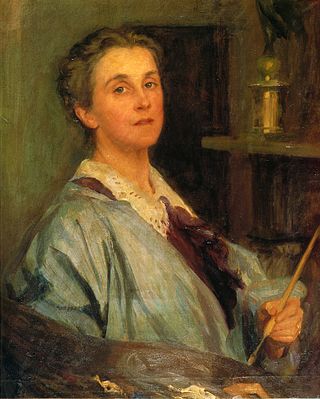
Lydia Field Emmet was an American artist best known for her work as a portraitist. She studied with, among others, prominent artists such as William Merritt Chase, Harry Siddons Mowbray, Kenyon Cox and Tony Robert-Fleury. Emmet exhibited widely during her career, and her paintings can now be found hanging in the White House, and many prestigious art galleries, including the Metropolitan Museum of Art.
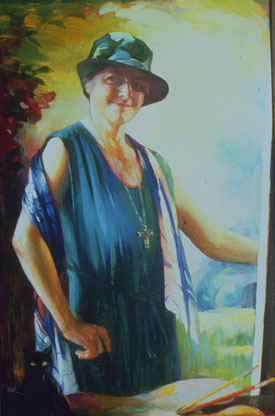
Ella Sophonisba Hergesheimer was an American illustrator, painter, and printmaker who painted and illustrated Tennessee society, including the state's women and children. As a printmaker, she pioneered the white-line woodcut.

Francis Luis Mora was a Uruguayan-born American figural painter. Mora worked in watercolor, oils and tempera. He produced drawings in pen and ink, and graphite; and etchings and monotypes. He is known for his paintings and drawings depicting American life in the early 20th century; Spanish life and society; historical and allegorical subjects; with murals, easel painting and illustrations. He also was a popular art instructor.

The Parrish Art Museum is an art museum designed by Herzog & de Meuron Architects and located in Water Mill, New York, whereto it moved in 2012 from Southampton Village. The museum focuses extensively on work by artists from the artist colony of the South Shore and North Shore.

Katharine Cotheal Budd (1860–1951) was a pioneering woman architect and author who ran a New York City architectural practice for over three decades. She became a member of the American Institute of Architects in 1924. She obtained an architectural license in Georgia in 1920.

Jenny Eakin Delony, also known as Jenny Eakin Delony Rice and Jenny Meyrowitz, (1866–1949) was an American painter and educator. She specialized in portraits of notable and historic figures in the United States, but also made miniature, landscape, wildlife, still life, and genre paintings. She was the founder of collegiate art education in Arkansas.
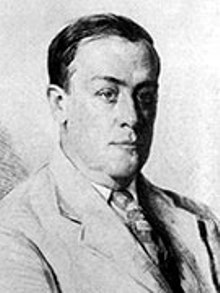
Rae Sloan Bredin was an American painter. He was a member of the New Hope, Pennsylvania school of impressionists. He is known for his peaceful spring and summer landscapes with relaxed groups of women and children.
The San Ildefonso school, also known as San Ildefonso Self-Taught Group, was an art movement from 1900–1935 featuring Native American artists primarily from the San Ildefonso Pueblo in New Mexico. The group consisted of Tonita Peña, Julian Martinez, Awa Tsireh, Crecencio Martinez, Jose Encarnacion Peña, and Luis Gonzales. This was the first known Native American group in the American Southwest to practice easel painting.
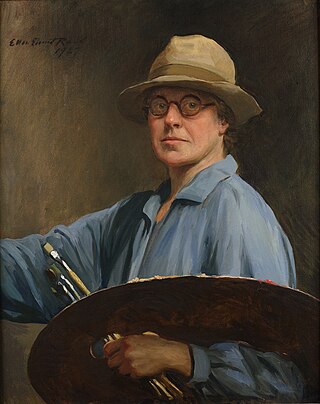
Ellen Emmet Rand was a painter and illustrator. She specialized in portraits, painting over 500 works during her career including portraits of President Franklin D. Roosevelt, artist Augustus Saint-Gaudens, and her cousins Henry James and William James. Rand studied at the Cowles Art School in Boston and the Art Students League in New York City and produced illustrations for Vogue Magazine and Harper's Weekly before traveling to England and then France to study with sculptor Frederick William MacMonnies. The William Benton Museum of Art at the University of Connecticut owns the largest collection of her painted works and the University of Connecticut, as well as the Archives of American Art within the Smithsonian Institution both have collections of her papers, photographs, and drawings.

Annie Traquair Lang was an American Impressionist painter, known for experimental impasto brushstrokes and jewel-tone abstracted forms. She exhibited portraits, still lifes and landscapes at two dozen venues in Europe and the U.S., and institutions including the Metropolitan Museum of Art acquired her works. She was acclaimed in publications including the New York Times and The International Studio. She also earned praise for her collection of paintings by her mentor, William Merritt Chase, with whom she traveled in Europe and California. She was considered the Chase pupil "who best assimilated his technique and verve."
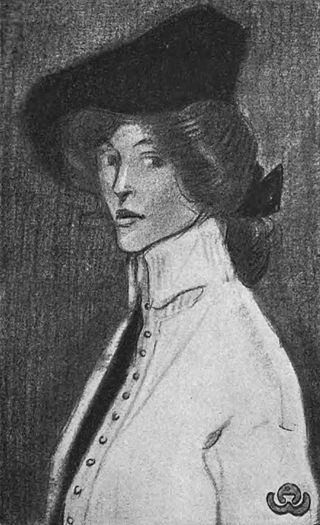
Alice Newton Woods Ullman was an American painter, illustrator, and writer.

Edith Mitchill Prellwitz (1865–1944) was an American artist who is known for Impressionist and Tonalist studies of Peconic Bay, New York, as well as for figurative paintings with literary or mythical subjects.

Channel "Chan" Pickering Townsley or C.P. Townsley (1867–1921) was an American painter, art administrator, and educator. The subject and genre of his California Impressionist paintings were landscapes, portraits and still lives. He served as a director of Otis Art Institute (1914–1921) and Stickney Memorial Art School (c.1912–1918).

A Friendly Call is an oil on canvas painting executed in 1895 by the American painter William Merritt Chase. It was acquired by the National Gallery of Art in Washington D.C., in 1943 as part of the Chester Dale collection.
